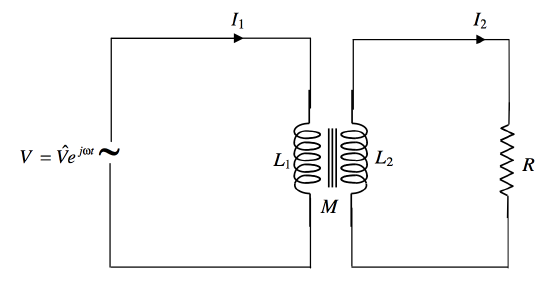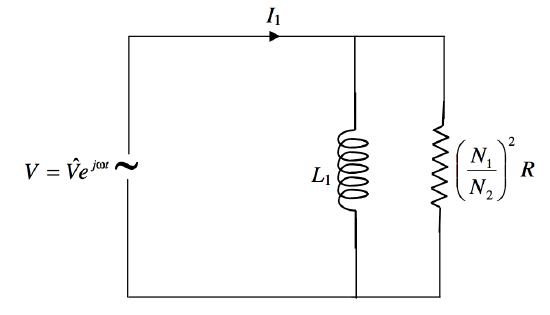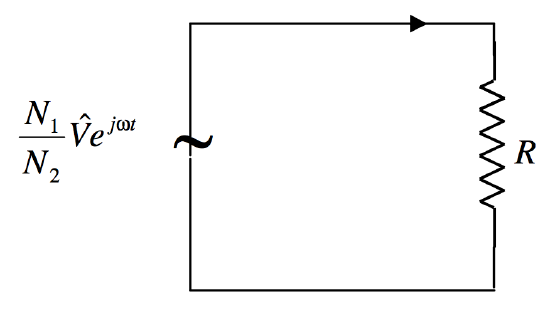13.10: The Transformer
( \newcommand{\kernel}{\mathrm{null}\,}\)
We met the transformer briefly in Section 10.9. There we pointed out that the EMF induced in the secondary coil is equal to the number of turns in the secondary coil times the rate of change of magnetic flux; and the flux is proportional to the EMF applied to the primary times the number of turns in the primary. Hence we deduced the well known relation
V2V1=N2N1
relating the primary and secondary voltages to the number of turns in each. We now look at the transformer in more detail; in particular, we look at what happens when we connect the secondary coil to a circuit and take power from it.

Figure XIII.12
In Figure XIII.12, we apply an AC EMF V=ˆVejωt to the primary circuit. The self inductance of the primary coil is L1, and an alternating current I1 flows in the primary circuit. The self inductance of the secondary coil is L2, and the mutual inductance of the two coils is M. If the coupling between the two coils is very tight, then M=√L1L2; otherwise it is less than this. I am supposing that the resistance of the primary circuit is much smaller than the reactance, so I am going to neglect it.
The secondary coil is connected to a resistance R. An alternating current I2 flows in the secondary circuit.
Let us apply Ohm's law (or Kirchhoff's second rule) to each of the two circuits.
In the primary circuit, the applied EMF V is opposed by two back EMF's:
V=L1˙I1+M˙I2.
That is to say
V=jωL1I1+jωMI2.
Similarly for the secondary circuit:
0=jωMI1+jωL2I2+RI2.
These are two simultaneous equations for the currents, and we can (with a small effort) solve them for I1 and I2:
[RL1M+j(ωL1L2M−ωM)]I1=(L2M−jRωM)V
and
[R+j(ωL2−ωM2L1)]I2=−MVL1.
This would be easier to understand if we were to do the necessary algebra to write these in the forms I1=(a+jb)V and I2=(c+jd)V. We could then easily see the phase relationships between the current and V as well as the peak values of the currents. There is no reason why we should not try this, but I am going to be a bit lazy before I do it, and I am going to assume that we have a well designed transformer in which the secondary coil is really tightly wound around the primary, and M=√L1L2 If you wish, you may carry on with a less efficient transformer, with M=k√L1L2 where k is a coupling coefficient less than 1, but I'm going to stick with M=√L1L2. In that case, Equations 13.10.5 and 6 eventually take the forms
I1=(L2L1R−j1L1ω)V=(N22N21R−j1L1ω)V
and
I2=−1R√L2L1V=−N2N1RV.
These equations will tell us, on examination, the magnitudes of the currents, and their phases relative to V.
Now look at the circuit shown in Figure XIII.13.

Figure XIII.13
In Figure XIII.13 we have a resistance R(N1/N2)2 in parallel with an inductance L1. The admittances of these two elements are, respectively, (N2/N1)2/R and −j/(L1ω), so the total admittance is N22N21R−j1L1ω. Thus, as far as the relationship between current and voltage is concerned, the primary circuit of the transformer is precisely equivalent to the circuit drawn in Figure XIII.13. To see the relationship between I1 and V, we need look no further than Figure XIII.13.
Likewise, Equation 13.10.8 shows us that the relationship between I2 and V is exactly as if we had an AC generator of EMF N2V/N1 connected across R, as in Figure XIII.14.

Figure XIII.14
Note that, if the secondary is short-circuited (i.e. if R=0 and if the resistance of the secondary coil is literally zero) both the primary and secondary current become infinite. If the secondary circuit is left open (i.e. R=∞), the secondary current is zero (as expected), and the primary current, also as expected, is not zero but is −jV/(L1ω); That is to say, the current is of magnitude V/(L1ω) and it lags behind the voltage by 90o, just as if the secondary circuit were not there.


